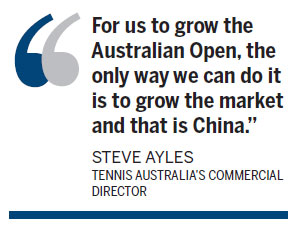|
Fans watch the match between Li Na and Olga Govortsova at the Australian Open on Wednesday. The Open is counting heavily on Chinese fans as it seeks to grow its audience. [Photo/Agencies] |
|
China's Li Na signs autographs for fans in Melbourne. [Photo/Agencies] |

Australian Open is cashing in on huge new audience in China, writes Sun Xiaochen in Melbourne.
Pound for pound, Chinese players might be the most lucrative athletes on the court at the Australian Open. Though their popularity at times outpaces their results, the Chinese have proven a boon for the tournament, increasing the tournament's appeal in the world's largest market and luring tourism dollars to the city.
In the crowded Garden Square that fronts Rod Laver Arena, countless Chinese fans can be seen wearing flaming flags painted on their faces, a scene reminiscent of the China Open or Shanghai Masters.
After the matches, the throngs migrate to merchandise booths to snap up Li Na souvenirs before dispersing to Melbourne's bars, restaurants and hotels for the night.
According to Tennis Australia, ticket sales from Chinese tour operators increased by 82 percent from last year's total of 2,592, and travel packages sold within China increased dramatically as well.
The tournament's merchandising arm has reached out to 8,000 outlets in China, and Chinese visitors contributed heavily to the $239 million take in Victoria in tourism and related activity.
That's a typical effect driven when an event draws Chinese interest, and a big part of the reason the tournament is attempting to open the door for the largest nation in the world.
"For us to grow the Australian Open, the only way we can do it is to grow the market and that is China," Steve Ayles, Tennis Australia's commercial director, told China Daily at his office in Melbourne Park on Thursday.
"For sure, China is critical for the future growth of the event. That's the biggest market we have an impact on. We are in a similar time zone. From the broadcasters' perspective, we penetrate the region much better."
Ayles' confidence stems from the event's TV audience in the Asia-Pacific region, which reached a record 198 million when Li fought into her first major final in 2011. That was followed by another 192 million last year.
"The history of Chinese players' dazzling performances has been a major advantage for us to better promote in the market, compared with the other three Slams," said Dean Brostek, the international business development manager for Tennis Australia.
In the wake of the women's emergence, the Chinese men's debut this year provided another opportunity. Asia-Pacific wild-card winner Wu Di drew visitors from both China and the local Chinese community.
Wu exited in the first round, but drew rabid support from Chinese fans and even some chants of support from the Aussies.
Australians Daniel Deangelis and Jordan Doddridge were Wu's most active supporters at courtside on Tuesday, flying China's national flag and wearing Chinese basketball jerseys.
"The Chinese are playing really well in tennis so we really enjoy watching them. We always went to watch the events in Shanghai and we thought we should go for the Chinese because we lived in China," said Doddridge, who studied at Dulwich College in Shanghai from 2009-11.
Charlie Bo, the CEO of the Melbourne-based Global Chinese Tennis Association, was also among the throng, which was organized by the association.
"Coming to support our players has been a must-do for local Chinese during the tournament every year," Bo told China Daily.
"A lot of people clear out their schedules at this time and join together to cheer for the Chinese players. That also strengthens emotional ties among Chinese immigrants in Australia."
A large portion of the Chinese market's potential remains untapped, though the tournament is working hard to rectify that.
The Open trophy traveled to six cities in China last September for the second time, and six ball kids from the China Open were invited to serve at this year's event as part of an exchange program.
And there's more to come.
"We are going to do more of that in future to get involved in the infrastructure development and the court service over there," Ayles said.
According to local media, the chief goal of the tournament's Asia-Pacific campaign is to increase the number of visitors traveling from Asia by 200 percent by 2016.
"The ticket sales are on the record, the biggest ever first-three-days attendance. We know this year we will set a record. We know that," Ayles said.
